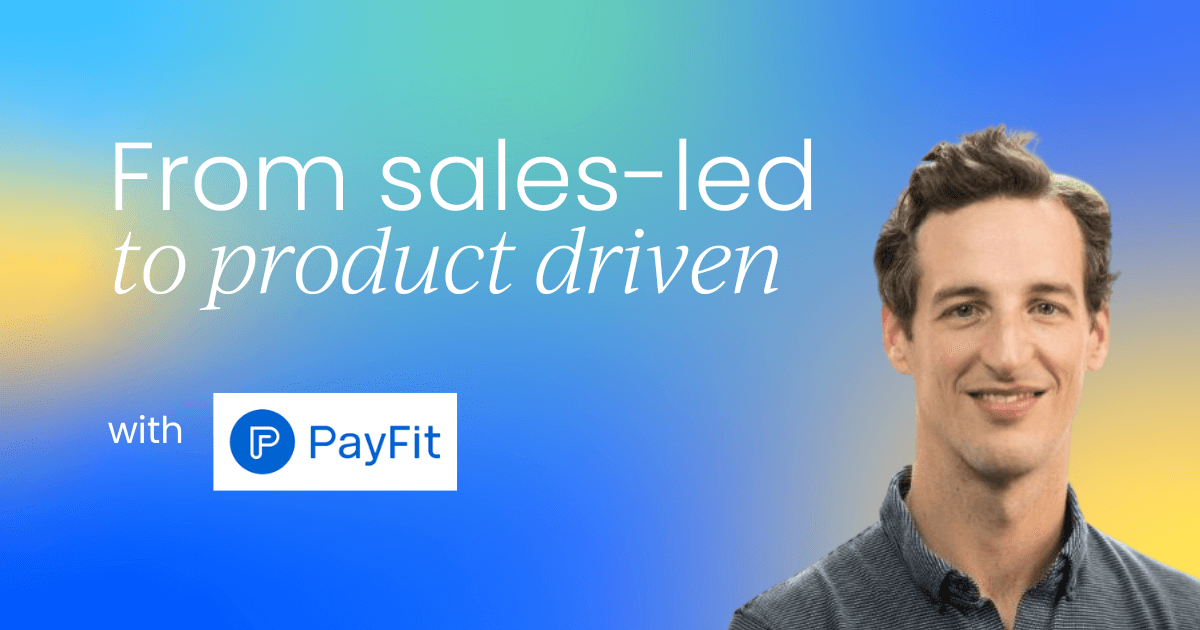This article is based on Sylvain’s appearance at the Chief Product Officer Summit in Amsterdam 2024.
Transforming a company's approach from sales-led to product-driven requires careful navigation and a deep understanding of both internal and external dynamics.
I'm Sylvain Grande, and with over twenty years of experience in product management and business strategy, I've had the opportunity to lead this transition at PayFit. Having worked in product-led B2C companies for the majority of my career, stepping into the B2B space of payroll presented unique challenges and insights.
In this article, I'll share our journey at PayFit, highlighting the importance of empathy, collaboration, and strategic integration as we shifted from a sales-led to a product-driven model.
Join me as I delve into the strategies and practical steps that have been essential in navigating this complex transformation and driving success for our business and our customers.
Navigating the transition from sales-led to product-driven at PayFit
At PayFit, we simplify payroll for small and medium-sized companies, targeting businesses with up to 100 employees.
Our goal is to provide a seamless service to non-experts across three very different countries: France, Spain, and the UK. France and Spain are notoriously complex when it comes to payroll, while the UK is comparatively straightforward. This diversity in our target markets introduces unique challenges in product development, particularly as companies grow and their level of expertise increases.
Importance of segmentation
Segmentation is crucial in the transition from a sales-led to a product-driven model. For the first seven and a half years, PayFit operated entirely with a sales-led acquisition model.
The product team was not involved in areas like the website, leading to a clear division of responsibilities: sales focused on signing contracts, marketing generated leads, and the product team took over once customers had access to the app. This delineation highlights the traditional sales-led approach we were following.
Another significant aspect is that payroll services don’t lend themselves to free trials or freemium models, which are common in other industries. Setting up payroll is a complex process that can take two to three weeks at best.
This complexity means that transitioning to a product-driven model involves more than just implementing standard practices; it requires adaptation to our specific context.
Payroll is inherently seasonal, with most employees receiving their payroll once or twice a month, typically at the end or middle of the month.
For B2B payroll providers, peak times vary by country: in the UK, the tax season is April-May, while in France, it’s January. This seasonality affects sales capacity planning and has a significant impact on how we approach the transition from sales-led to product-driven.
The macroeconomic environment also plays a crucial role. Given the current economic climate, characterized by slower growth and reduced hiring, we had to re-evaluate our unit economics and sales strategies.
We asked ourselves fundamental questions about where to focus our sales efforts, particularly in relation to different customer segments. Simple math revealed that the lifetime value to customer acquisition cost ratio for smaller clients made extensive outbound sales efforts on these segments less worthwhile.
The journey from sales-led to product-driven at PayFit is shaped by a variety of factors: market segmentation, the complexity of payroll services, seasonal dynamics, and the broader economic context.
Understanding these nuances is essential for successfully navigating this transformation and tailoring our approach to fit the unique needs of our business and customers.

Embarking on the journey from sales-led to product-driven
When we embarked on the journey from sales-led to product-driven, it was crucial to recognize that this transition isn't about replacing one channel with another. Instead, it's about adding new channels to complement the existing ones. The objective is not to fully replace the sales-led approach but to create an additive model.
In our company culture, people often have a tendency to oppose different approaches. For instance, product teams might view sales feedback skeptically, believing that salespeople don't understand the product.
Conversely, sales teams might feel that product teams never deliver the features they need. This adversarial mindset is counterproductive, especially when trying to integrate new channels.
The idea that adding a new channel will magically shift a certain percentage of leads entirely to that channel is a misconception. In reality, there is a lot of back and forth between channels.
It's essential to consider not just the first and last touches but also the drop-off rates. This requires a nuanced approach, assessing whether to address these through marketing nurturing, product features, or targeted sales engagement at specific moments.
Segmentation plays a vital role in this transition. We began with the easiest segment, targeting businesses with 0 to 10 employees, and then expanded to the 10 to 25 range within our 0 to 100 spectrum. The goal was to introduce product-driven thinking as early as possible in the funnel, gradually scaling up.
The journey from sales-led to product-driven at PayFit involves a complex interplay of channels, requiring careful consideration of cultural dynamics, customer segmentation, and the integration of various touchpoints. By approaching this transformation with a mindset of addition rather than replacement, we can more effectively navigate the challenges and opportunities that arise.
Managing human change and incentives
One often overlooked aspect of transitioning from a sales-led to a product-driven model is human change management, particularly around incentives.
How many product people have had conversations about sales incentives? These discussions are fundamental when embarking on such a change. When you transition, the first thought for a salesperson is, "I'm going to lose my commission."
Initially, it makes sense to reassure them by maintaining their compensation at 100%, but eventually, this might not be sustainable from a unit economics standpoint.
We also introduced affiliates, which account for about 10% of our leads. Initially managed through sales, we have now started to incorporate them into our self-acquisition funnel. Additionally, partnerships, which were scarce in our context, have been expanded.
These partnerships tend to cater more to smaller clients and are funneled through our self-serve model. However, sales teams often see these new elements as competing interests.
To address these concerns, it's crucial to engage in conversations with sales teams, emphasizing that the goal is to generate more qualified leads that are easier to close. We also provide training on aspects of a product-led culture and involve sales in closing specific drop-offs in the funnel in an organized manner.
While we haven't completed this transition, we've made significant progress over the past year. By explicitly addressing incentives and integrating new channels like affiliates and partnerships, we've evolved considerably.
This evolution requires ongoing dialogue and adjustments to ensure that all teams are aligned and that the transition benefits the entire organization.

Beyond acquisition: The complexity of activation
While acquisition is crucial, it's just the beginning when it comes to payroll. Signing a contract, though challenging, pales in comparison to what comes next: onboarding, or what we in product terms call activation. Activation is the most complex part of the process.
In most countries, onboarding requires an extensive amount of data about each employee. For instance, in France, we need ninety data points per employee, along with company details and historical data about social declarations and organizations. Many companies struggle to locate or understand these requirements.
When we began our journey towards a product-driven model, we initially focused on self-acquisition, aiming to simplify the process for customers and ease the sales and signature process. However, this was just the first step. The real transformation needed to happen internally, where onboarding was handled manually by our customer service team, known as the onboarding team.
Our next challenge was to shift the focus from assisting internal teams to helping clients directly. This cultural shift was significant. Our customer service team, which makes up about 30% of our staff, is a vital source of feedback and input.
Historically, our product management team has had strong empathy towards this team, which, while beneficial, sometimes led us to prioritize internal needs over those of our primary users: the end users and administrators who actually pay for our services.
We needed to strike a balance, ensuring that while we support our internal teams, our primary focus remains on the end users. This shift required a cultural change and brought its own set of tensions, but it was necessary for the successful transition from a sales-led to a product-driven approach.
The transition from sales-led to product-driven is more than just altering the sales process. It involves a comprehensive transformation that affects every part of the organization, especially in complex fields like payroll.
Comprehensive life cycle thinking
While acquisition is a significant focus, it's essential to adopt an end-to-end and systemic approach to the product life cycle. This encompasses discovery, acquisition, onboarding, usage, and upsell.
In our case, the final part of the life cycle involves not just running payroll but also sending data to social organizations and receiving their feedback. This process is complex and challenging even for our customers to grasp.
We have implemented various upsell strategies, which are fundamental in the context of our cultural shift from sales-led to product-driven. Initially, within our sales team, less than ten percent focused on expansion.
We started by targeting a segment of customers that the sales team deemed less problematic, gradually moving up the scale. This shift raised concerns among salespeople about their roles and commissions. To address this, we provided them with more data on customer behavior and specific segments to pursue, complementing the self-upsell approach.
In a product-driven model, achieving a hundred percent conversion rate on upsell mechanisms or clicks is unrealistic. The challenge lies in effectively leveraging sales and marketing within the right segments, always guided by unit economics.
We are still in the midst of our transition. While I wouldn't claim that we've completed this journey in just a year and a half, we have made significant strides. My previous experience at companies like SoundCloud, where growth was purely product-driven, contrasts with the complexities we face at PayFit. There, growing from five million to two hundred million users was straightforward compared to our current challenges.
We anticipate that this cultural transformation will take another year. Culture change must permeate all teams. It's not just about salespeople understanding the new model; product teams also need to grasp unit economics differently.
Previously, we didn't focus on the unit economics of acquisition or activation. In payroll, signing a customer with complex use cases that we can't serve is detrimental to both the customer and the company.
Addressing payroll complexity
Payroll is inherently complex, often outsourced to large companies or accountants, especially for bigger organizations.
Our solution offers a software-as-a-service model for small companies, empowering them to take control of this anxiety-inducing task. While we promise more control and freedom, the reality is that businesses still need to insource payroll processes. This introduces a unique challenge: convincing users that they can handle this responsibility confidently.
Salespeople might excel at convincing prospects and closing deals, but demonstrating the time to value is a different challenge. In payroll, time to value is inherently slow; running the first payroll cannot be expedited. This necessitates a reevaluation of how we showcase value quickly.
For example, on the product side, we had to rethink our approach. Running payroll, while central to our business, does not immediately show fast time to value. This realization led to a significant evolution for our product teams. We had to incorporate elements that provide quicker wins and reassurance to new users.
Transitioning from a human touch model to a product-driven approach required significant changes. This included updating our website, adding in-app guidance, and creating resources that address the complexity of payroll.
Unlike other products, payroll is text-heavy by nature, and simplification must be carefully balanced to avoid inaccuracies. This creates unique challenges in managing the full life cycle within a product-driven framework.
Bridging the gap between sales and product
To successfully blend the sales-led and product-driven worlds, it's crucial to foster mutual understanding of each other's incentives. I want everyone on my team to grasp how salespeople think, their incentive structures, and how these evolve.
For example, sales incentives might be based primarily on sign-ups, but with penalties for high drop-off rates during activation. This is important because we do experience some drop-offs, and addressing this can improve our overall strategy.
Conversely, it's essential for salespeople to understand that product teams operate differently. An interesting development occurred a few months back when some product team members asked if they could receive bonuses for achieving self-acquisition revenue targets. It sparked a valuable conversation about incentives and how they can be aligned in other ways. This kind of dialogue is positive and fosters a deeper understanding and collaboration between teams.
The transition to a product-driven model also necessitates rethinking many internal processes, particularly around data. Traditionally, the product team focused on the user experience post-contract, while the data team managed separate sales processes. However, integrating both sales and product funnels requires a unified approach to data attribution, touchpoints, and definitions.
Our data team had to adapt to this new reality, merging data from different funnels and rethinking definitions to align with the sales team's perspective. This alignment is critical, as it ensures that everyone —from sales to product to finance— operates with a consistent understanding of the funnel and its metrics.
A key aspect of this integration is establishing an aligned taxonomy that all teams can understand. This involves redefining how we look at the funnel, ensuring that sales, product, and finance teams share a common language and understanding. For example, revenue recognition and category definitions needed to be standardized to avoid confusion and ensure accurate reporting.
Rethinking time to value
In the context of payroll, speeding up the process isn't always feasible. Our standard benchmark is that the fastest we can go from signing a contract to running payroll is fifteen days. Coming from a background where fifteen days seems intolerably long, we had to adjust our expectations.
However, we've managed to make these fifteen days more efficient by focusing on the median time spent in the app completing necessary activities. Currently, this stands at 3.5 hours, which is remarkable. Although the fifteen days haven't disappeared, the active work required within that period has been significantly condensed.
To provide a clearer perspective, it's essential to consider both the customer experience and the internal processes. For customers, the fifteen-day timeline includes just 3.5 hours of active engagement, making the process more manageable and less daunting. Internally, this understanding helps us balance the sales cycle with what's happening in the product development phase.
Initially, we underestimated the importance of integrating content to further activate users within the product. This required us to deeply rethink our approach to content and segmentation, a new skill set for our product team.
The goal was to provide relevant and timely information that would help users navigate the complexities of payroll more effectively.
This transition also highlighted the broader scope of work involved in product management. It's not just about managing features but understanding and integrating various systems and processes. For example, ensuring proper packaging in Zuora for finance recognition, aligning Salesforce processes, and linking HubSpot leads are all critical components of the product function.
Sometimes, the way the organization views product management can be narrow, focusing only on the visible aspects. However, the full cycle of product work involves much more. The behind-the-scenes integration of various tools and processes is vital for the smooth operation of the product and the overall business.
The journey from sales-led to product-driven involves a comprehensive rethinking of time to value, content integration, and the broader scope of product management.
Final thoughts
The key takeaway is to avoid fostering prejudices or setting up oppositional dynamics between channels. The goal isn't to turn sales and product teams into best friends with shared incentives, but rather to build empathy and find concrete ways for products to help salespeople achieve their targets while aligning with the broader unit economics of the business.
Creating a culture of empathy between sales and product teams is crucial. Understanding each other's challenges and motivations helps in developing solutions that benefit both sides. For example, product teams can support sales by providing tools and insights that make it easier for salespeople to close deals and retain customers. This collaboration ensures that both teams are working towards the same business objectives.
When adding a new channel, it's important to remember that you aren't simply replacing an old one. Instead, you're creating multiple new pathways. Each new channel introduces various ways for customers to interact with your product, and this complexity requires careful management and integration.
Our journey is far from over. The cultural change necessary to fully transition to a product-driven approach is ongoing and requires continuous effort and adaptation. By maintaining a focus on empathy, collaboration, and strategic integration of channels, we can continue to evolve and improve our processes, ultimately benefiting both our customers and our business.



 Follow us on LinkedIn
Follow us on LinkedIn




